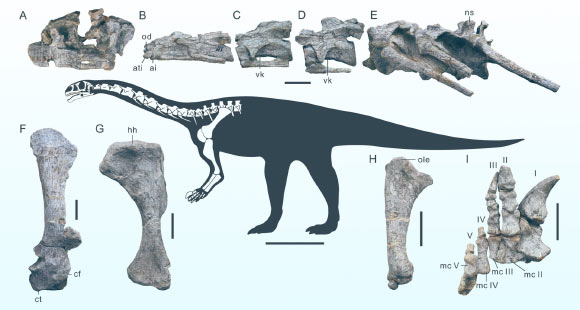Wudingloong wui lived in what is now Yunnan, China, around 200 million years ago (Early Jurassic epoch).
Reconstructed skeleton and representative bones of Wudingloong wui. Individual scale bars – 5 cm. Scale bar of the reconstructed skeleton – 50 cm. Image credit: Wang et al., doi: 10.1038/s41598-025-12185-2.
Wudingloong wui was a small- to medium-sized non-sauropodan member of Sauropodomorpha, one of the most successful dinosaurian groups with an almost global distribution, spanning from Antarctica to Greenland.
“Chinese non-sauropodan sauropodomorphs are mainly known in the Lower Jurassic Lufeng Formation in Lufeng and its neighboring areas, Yunnan province, and they are represented by Lufengosaurus, Yunnanosaurus, Jingshanosaurus, Xingxiulong, Yizhousaurus, and some other species,” said Geological Museum of China paleontologist Ya-Ming Wang and colleagues.
“Qianlong, which was reported from the Lower Jurassic Ziliujing Formation of neighboring Guizhou province, represents a recent discovery expanding our understanding on the distribution of the non-sauropodan sauropodomorphs in China.”
“The discovery of Wudingloong wui provides further evidence that the southwestern China sauropodomorph assemblage is one of the most taxonomically diverse and morphologically disparate in the pre-Toarcian Early Jurassic worldwide, represented by various species from near the base of the Massopoda to non-sauropodan sauropodiforms.”
The fossilized bones of Wudingloong wui were collected from the Yubacun Formation at Wande town in China’s Yunnan province.
“The specimen is a partial skeleton including skull and mandible, atlas-axis, third to the tenth cervical vertebrae, first to the seventh dorsal vertebrae, dorsal ribs, right scapula and coracoid, right forelimb including humerus, ulna, radius, and manus,” the paleontologists said.
“The fully co-ossified cranial elements and completely closed neurocentral sutures of the vertebrae demonstrates that the specimen was probably a mature individual.”
Wudingloong wui represents the earliest-diverging and stratigraphically oldest sauropodomorph dinosaur discovered in East Asia so far.
“The new species is placed as an earlier-diverging sauropodomorph than Massospondylidae and Sauropodiformes, which adds new information to the sauropodomorph assemblage of southwestern China,” the researchers said.
“Therefore, the Early Jurassic southwestern China sauropodomorph assemblage is now probably represented by four unique associations of species, including the relatively small and gracile Wudingloong, the medium-sized massospondylid Lufengosaurus (and possibly Xixiposaurus), the medium-large-bodied and possibly quadrupedal massopodans, and the early-diverging sauropodiforms, which is similar to the Late Triassic-Early Jurassic early sauropodomorph assemblages that have a wider time range, including the Elliot Formation of South Africa, the South America, and the Zimbabwean sauropodomorph assemblages.”
“The close phylogenetic relationship between Wudingloong and Plateosauravus from the Late Triassic Lower Elliot Formation of South Africa and Ruehleia from the Late Triassic of Germany indicates that the dispersal of early sauropodomorphs in East Asia either occurred at least in Rhaetian (206 to 201.4 million years ago) of the Late Triassic or just happened around the Triassic-Jurassic boundary (201.4 million years ago).”
“Further discoveries of more specimens and other analyses are necessary to test this hypothesis.”
“Nonetheless, the discovery of Wudingloong raises the question about the association between the distribution of the East Asian non-sauropodan sauropodomorphs and the Triassic-Jurassic extinction event.”
The team’s paper was published in the journal Scientific Reports.
_____
YM. Wang et al. 2025. A new Early Jurassic dinosaur represents the earliest-diverging and oldest sauropodomorph of East Asia. Sci Rep 15, 26749; doi: 10.1038/s41598-025-12185-2
